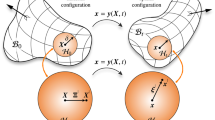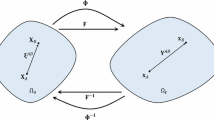Abstract
We verify the objectivity (invariance to rigid body rotations) ordinary state-based peridynamic models published in the literature that differ in their formulas. We find and explain the sources for the differences between these published formulas. We demonstrate that a primary cause leading to these differences is the way in which the peridynamic volume dilatation is defined in the different formulations. We show that the equations of motion derived from one approach apply to deformations with small or large rotations and is objective. The other approach is valid only for deformations with zero/infinitesimal rotations, thus it is not objective. We also show that both state-based models recover the correct bond-based formulations with the appropriate Poisson ratio values when the term containing the volume dilatation vanishes.
Similar content being viewed by others
Notes
Note: the derivation below was kindly suggested by one of the three anonymous reviewers, who also gave us permission to include it in the manuscript. We thank the reviewer.
References
Silling, S.A., Askari, E.: A meshfree method based on the peridynamic model of solid mechanics. Comput. Struct. 83, 1526–1535 (2005)
Silling, S.A., Epton, M., Weckner, O., Xu, J., Askari, E.: Peridynamic states and constitutive modeling. J. Elast. 88, 151–184 (2007)
Sarego, G., Le, Q.V., Bobaru, F., Zaccariotto, M., Galvanetto, U.: Linearized state-based peridynamics for 2D problems. Int. J. Numer. Methods Eng. 108, 1174–1197 (2016)
Madenci, E., Oterkus, E.: Peridynamic Theory and Its Applications. Springer, Berlin (2014)
Oterkus, E., Madenci, E.: Ordinary state-based peridynamic material constants. In: 53rd AIAA/ASME/ASCE/AHS/ASC Structures, Structural Dynamics and Materials Conference 20th AIAA/ASME/AHS Adaptive Structures Conference 14th AIAA, p. 1946 (2012)
Madenci, E., Oterkus, S.: Ordinary state-based peridynamics for plastic deformation according to von Mises yield criteria with isotropic hardening. J. Mech. Phys. Solids 86, 192–219 (2016)
Le, Q.V., Chan, W.K., Schwartz, J.: A two-dimensional ordinary, state-based peridynamic model for linearly elastic solids. Int. J. Numer. Methods Eng. 98, 547–561 (2014)
Silling, S.A.: Reformulation of elasticity theory for discontinuities and long-range forces. J. Mech. Phys. Solids 48, 175–209 (2000)
Bobaru, F., Hu, W.: The meaning, selection, and use of the peridynamic horizon and its relation to crack branching in brittle materials. Int. J. Fract. 176, 215–222 (2012)
Silling, S.A., Lehoucq, R.B.: Peridynamic theory of solid mechanics. Adv. Appl. Mech. 44, 73–168 (2010)
Aguiar, A.R., Fosdick, R.: A constitutive model for a linearly elastic peridynamic body. Math. Mech. Solids 19, 502–523 (2014)
Aguiar, A.R.: On the determination of a peridynamic constant in a linear constitutive model. J. Elast. 122, 27–39 (2016)
Oterkus, S., Madenci, E.: Peridynamics for antiplane shear and torsional deformations. J. Mech. Mater. Struct. 10, 167–193 (2015)
Le, Q., Chan, W.K., Schwartz, J.: Two-dimensional peridynamic simulation of the effect of defects on the mechanical behavior of Bi2Sr2CaCu2Ox round wires. Supercond. Sci. Technol. 27, 115007 (2014)
Foster, J.T., Silling, S.A., Chen, W.: An energy based failure criterion for use with peridynamic states. Int. J. Multiscale Comput. Eng. 9, 675–688 (2011)
Foster, J.T., Silling, S.A., Chen, W.W.: Viscoplasticity using peridynamics. Int. J. Numer. Methods Eng. 81, 1242–1258 (2010)
Silling, S.A.: Linearized theory of peridynamic states. J. Elast. 99, 85–111 (2010)
Mitchell, J.A., Nonlocal, A.: Ordinary, State-Based Plasticity Model for Peridynamics. Sandia National Laboratories, vol. SAND2011-3166 (2011)
van der Merwe, C.W.: A peridynamic model for sleeved hydraulic fracture. Master of Engineering Thesis, Stellenbosch University (2014). http://hdl.handle.net/10019.1/95993
Han, F., Lubineau, G., Azdoud, Y., Askari, A.: A morphing approach to couple state-based peridynamics with classical continuum mechanics. Comput. Methods Appl. Mech. Eng. 301, 336–358 (2016)
Seleson, P., Parks, M.: On the role of the influence function in the peridynamic theory. Int. J. Multiscale Comput. Eng. 9, 689–706 (2011)
Seleson, P., Parks, M.L., Gunzburger, M.: Peridynamic state-based models and the embedded-atom model. Commun. Comput. Phys. 15, 179–205 (2014)
Thorpe, M., Jasiuk, I.: New results in the theory of elasticity for two-dimensional composites. In: Proceedings of the Royal Society of London A: Mathematical, Physical and Engineering Sciences, vol. 438, pp. 531–544 (1992)
Lehoucq, R.B., Silling, S.A.: Force flux and the peridynamic stress tensor. J. Mech. Phys. Solids 56, 1566–1577 (2008)
Silling, S., Littlewood, D., Seleson, P.: Variable horizon in a peridynamic medium. J. Mech. Mater. Struct. 10, 591–612 (2015)
Gerstle, W.H., Sau, N., Silling, S.A.: Peridynamic modeling of plain and reinforced concrete structures. In: 18th International Conference on Structural Mechanics in Reactor Technology, Beijing, China (2005)
Bobaru, F., Yang, M., Alves, L.F., Silling, S.A., Askari, E., Xu, J.: Convergence, adaptive refinement, and scaling in 1D peridynamics. Int. J. Numer. Methods Eng. 77, 852–877 (2009)
Bobaru, F., Ha, Y.D.: Adaptive refinement and multiscale modeling in 2D peridynamics. J. Multiscale Comput. Eng. 9, 635–660 (2011)
Acknowledgements
This work has been supported by AFOSR MURI Center for Materials Failure Prediction through Peridynamics (program managers Drs. James Fillerup, Ali Sayir, David Stargel, and Fariba Fahroo), by a grant from ARO (program managers Dr. Larry Russell), and by ONR (program manager William Nickerson). We would like to thank Dr. Stewart Silling, Prof. Erdogan Madenci and Prof. Erkan Oterkus for very helpful discussions. We also thank the anonymous reviewer who pointed out a possible derivation for the nonlocal dilatation formula in Sect. 2.2.2 and gave us permission to include it here.
Author information
Authors and Affiliations
Corresponding author
Appendices
Appendix A: Peridynamic States and Their Operations
The peridynamic states and their operations are defined in [2]. Below is a summary of the basic concepts.
Definition 1
Let ℋ be a neighborhood of radius \(\delta\) centered at the origin in \(\mathbb{R}^{3}\). Let \(\mathcal{L}_{m}\) denote the set of all tensors of order \(m\). Then a state of order \(m\) is a function \(\underline{\mathbf{A}} \langle \boldsymbol{\cdot} \rangle \mathcal{:H\rightarrow L}_{m}\).
A peridynamic state maps a peridynamic bond vector (\(\boldsymbol{\xi}\)) to a tensor of order \(m\). Examples of peridynamic states include: the reference position scalar state \(\underline{x} \) (mapping a bond vector to its undeformed bond length), extension scalar state \(\underline{e} \) (mapping a bond vector to the bond’s elongation), force vector state \(\underline{\mathbf{T}} \) (mapping a bond vector to the bond’s force density vector).
Definition 2
Let \(\underline{\mathbf{A}} \in \mathcal{A}_{m}\) and \(\underline{\mathbf{B}} \in \mathcal{A}_{m}\). The sum and the difference of the states \(\underline{\mathbf{A}}\) and \(\underline{\mathbf{B}}\) are, respectively:
Definition 3
The point product of two states \(\underline{\mathbf{A}} \in \mathcal{A}_{m+p}\) and \(\underline{\mathbf{B}} \in \mathcal{A}_{p}\) is a state in \(\mathcal{A}_{m}\) and defined by:
Similarly,
Note that in this definition, the Einstein summation notation is used, i.e., the summation over all the \(j_{1} \dots j_{p}\) components. The point product of two states is not necessarily commutative. If at least one of the two states is a scalar state, then their point product is commutative.
Definition 4
The dot product of two states \(\underline{\mathbf{A}}\) and \(\underline{\mathbf{B}}\) is:
Note that the dot product of two states is not a state, unlike the point product in Definition 3.
Appendix B: Testing the Dilatation Terms of Approaches A and B in 3D
Testing conditions:
To compare the value of classical volume dilation with the peridynamic volume dilation formulas given by Eqs. (7) and (14), we subject an elastic material to a homogeneous deformation given by \(( \boldsymbol{\xi} + \boldsymbol{\eta}) = \mathbf{F}. \boldsymbol{\xi}\), where \(\mathbf{F}\) is the classical deformation gradient tensor. We test three cases: (i) large strains and no rotations; (ii) small strains and large rotations, and (iii) small strains and no rotations. Here are some specific values for \(\mathbf{F}\):
For these corresponding deformations, we compute the peridynamic dilatations given by Eqs. (7) and (14) by numerical integration. We use numerical integration in Matlab (‘integral3’ function), and the integration region is a sphere of radius 1 \((\delta=1)\). We find the corresponding peridynamic dilatations \(\theta_{\mathrm{A}}\) and \(\theta_{\mathrm{B}}\). For case (i) we get \(\theta_{\mathrm{A}} \approx3.1557\) and \(\theta_{\mathrm{B}} \approx 3.3037\), both different from the value 5 obtained above. This verifies that approached A and B are not applicable for the case of large strains. For case (ii) we get \(\theta_{\mathrm{A}} \approx 1.0000\times 10^{-2}\) and \(\theta_{\mathrm{B}} \approx 3.0000\times 10^{-2}\). The volume dilatation formula from approach B gives a value which is only 1% different from the classical volume dilation, while approach A cannot be used for this case. For case (iii) we obtain \(\theta_{\mathrm{A}} \approx 2.0139\times 10^{-2}\) and \(\theta_{\mathrm{B}} \approx 2.0139\times 10^{-2}\). In this case, both formulas give results that are about 1% different from the classical value.
Rights and permissions
About this article
Cite this article
Van Le, Q., Bobaru, F. Objectivity of State-Based Peridynamic Models for Elasticity. J Elast 131, 1–17 (2018). https://doi.org/10.1007/s10659-017-9641-6
Received:
Published:
Issue Date:
DOI: https://doi.org/10.1007/s10659-017-9641-6




